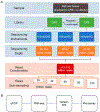Impact of Sequencing Depth and Library Preparation on Toxicological Interpretation of RNA-Seq Data in a "Three-Sample" Scenario
- PMID: 33354967
- PMCID: PMC7887111
- DOI: 10.1021/acs.chemrestox.0c00368
Impact of Sequencing Depth and Library Preparation on Toxicological Interpretation of RNA-Seq Data in a "Three-Sample" Scenario
Abstract
While RNA-sequencing (RNA-seq) has emerged as a standard approach in toxicogenomics, its full potential in gaining underlying toxicological mechanisms is still not clear when only three biological replicates are used. This "three-sample" study design is common in toxicological research, particularly in animal studies during preclinical drug development. Sequencing depth (the total number of reads in an experiment) and library preparation are critical to the resolution and integrity of RNA-seq data and biological interpretation. We used aflatoxin b1 (AFB1), a model toxicant, to investigate the effect of sequencing depth and library preparation in RNA-seq on toxicological interpretation in the "three-sample" scenario. We also compared different gene profiling platforms (RNA-seq, TempO-seq, microarray, and qPCR) using identical liver samples. Well-established mechanisms of AFB1 toxicity served as ground truth for our comparative analyses. We found that a minimum of 20 million reads was sufficient to elicit key toxicity functions and pathways underlying AFB1-induced liver toxicity using three replicates and that identification of differentially expressed genes was positively associated with sequencing depth to a certain extent. Further, our results showed that RNA-seq revealed toxicological insights from pathway enrichment with overall higher statistical power and overlap ratio, compared with TempO-seq and microarray. Moreover, library preparation using the same methods was important to reproducing the toxicological interpretation.
Conflict of interest statement
The authors declare no competing financial interest.
Figures







Similar articles
-
RNA-Seq profiling reveals novel hepatic gene expression pattern in aflatoxin B1 treated rats.PLoS One. 2013 Apr 22;8(4):e61768. doi: 10.1371/journal.pone.0061768. Print 2013. PLoS One. 2013. PMID: 23630614 Free PMC article.
-
Evaluation of the coverage and depth of transcriptome by RNA-Seq in chickens.BMC Bioinformatics. 2011 Oct 18;12 Suppl 10(Suppl 10):S5. doi: 10.1186/1471-2105-12-S10-S5. BMC Bioinformatics. 2011. PMID: 22165852 Free PMC article.
-
Impact of library preparation on downstream analysis and interpretation of RNA-Seq data: comparison between Illumina PolyA and NuGEN Ovation protocol.PLoS One. 2013 Aug 19;8(8):e71745. doi: 10.1371/journal.pone.0071745. eCollection 2013. PLoS One. 2013. PMID: 23977132 Free PMC article.
-
Comparing next-generation sequencing and microarray technologies in a toxicological study of the effects of aristolochic acid on rat kidneys.Chem Res Toxicol. 2011 Sep 19;24(9):1486-93. doi: 10.1021/tx200103b. Epub 2011 Aug 23. Chem Res Toxicol. 2011. PMID: 21834575
-
Bias in RNA-seq Library Preparation: Current Challenges and Solutions.Biomed Res Int. 2021 Apr 19;2021:6647597. doi: 10.1155/2021/6647597. eCollection 2021. Biomed Res Int. 2021. PMID: 33987443 Free PMC article. Review.
Cited by
-
Deciphering Aflatoxin B1 affected critical molecular pathways governing cancer: A bioinformatics study using CTD and PANTHER databases.Mycotoxin Res. 2025 Feb;41(1):93-111. doi: 10.1007/s12550-024-00563-0. Epub 2024 Oct 17. Mycotoxin Res. 2025. PMID: 39417919
-
A comparison of the TempO-Seq and Affymetrix microarray platform using RTqPCR validation.BMC Genomics. 2024 Jul 3;25(1):669. doi: 10.1186/s12864-024-10586-7. BMC Genomics. 2024. PMID: 38961363 Free PMC article.
-
Short-term in vivo testing to discriminate genotoxic carcinogens from non-genotoxic carcinogens and non-carcinogens using next-generation RNA sequencing, DNA microarray, and qPCR.Genes Environ. 2023 Feb 9;45(1):7. doi: 10.1186/s41021-023-00262-9. Genes Environ. 2023. PMID: 36755350 Free PMC article. Review.
-
Applying genomics in regulatory toxicology: a report of the ECETOC workshop on omics threshold on non-adversity.Arch Toxicol. 2023 Aug;97(8):2291-2302. doi: 10.1007/s00204-023-03522-3. Epub 2023 Jun 9. Arch Toxicol. 2023. PMID: 37296313 Free PMC article.
References
-
- Mortazavi A, Williams BA, McCue K, Schaeffer L, and Wold B (2008) Mapping and quantifying mammalian transcriptomes by RNA-Seq. Nat. Methods 5, 621–628. - PubMed
-
- Wang C, Gong B, Bushel PR, Thierry-Mieg J, Thierry-Mieg D, Xu J, Fang H, Hong H, Shen J, Su Z, Meehan J, Li X, Yang L, Li H, Labaj PP, Kreil DP, Megherbi D, Gaj S, Caiment F, van Delft J, Kleinjans J, Scherer A, Devanarayan V, Wang J, Yang Y, Qian HR, Lancashire LJ, Bessarabova M, Nikolsky Y, Furlanello C, Chierici M, Albanese D, Jurman G, Riccadonna S, Filosi M, Visintainer R, Zhang KK, Li J, Hsieh JH, Svoboda DL, Fuscoe JC, Deng Y, Shi L, Paules RS, Auerbach SS, and Tong W (2014) The concordance between RNA-seq and microarray data depends on chemical treatment and transcript abundance. Nat. Biotechnol 32, 926–932. - PMC - PubMed
Publication types
MeSH terms
Substances
Grants and funding
LinkOut - more resources
Full Text Sources
Molecular Biology Databases

